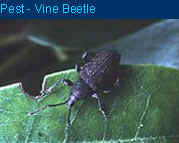|
|
|
|||||
|
|
||||||
|
||||||||||
|
Fast Growing Trees Fastest
Deciduous |
|
Faster
Deciduous |
|
Fast
Deciduous
Evergreen |
|
Fast Growing
Hedging Plants
Deciduous
Evergreen
Arborvitae
Douglas Fir |
|
Other unwelcome visitors: cats | foxes | frogs | moles :: pests and diseases | ants | aphids | blackspot | botrytis - gray mold | caterpillars | Japanese beetle larvae | leatherjackets | mealybugs | powdery mildew | red spider mite | rust | slugs and snails | vine weevils | whitefly |
|
|
 Signs
- Irregular notches taken from the margins of the leaves are made by the
adult weevil. If a plant suddenly dies and appears to have no roots, this
is the work of the larvae.
Signs
- Irregular notches taken from the margins of the leaves are made by the
adult weevil. If a plant suddenly dies and appears to have no roots, this
is the work of the larvae.
The way you usually find out is by looking at a poorly looking plant, when you go to pick off a dead leaf, the whole lot lifts from the roots in your hand - it's a bit late by then though. Adults may be seen around plants, look for cream / white larvae in compost when re-potting plants.
Damage - The worst damage is from the grubs and to the roots of plants, particularly of plants grown in containers. Depends on the size of the root system and the number of grubs eating it. Growth will slow, the plant may then begin to wilt and finally die as it no longer has sufficient roots to sustain it. Unfortunately by the time it has been discovered it is usually to late to take steps for that plant, though others not so far gone can be protected.
Adult vine weevils can cause damage in particular to Rhododendrons
Treatment - Adult vine weevils cannot fly and are mainly nocturnal, during the day they burrow in the soil or live amongst fallen leaves and the like around plants and herein could lie their downfall. You could try leaving pieces of folded sacking or rolled up corrugated cardboard in likely spots and then the next day destroy them along with any caught vine weevils.
In the longer term, good hygiene, clearing away fallen leaves and debris helps too.
To deal with the larvae is more difficult as they soon get to a size where they are large enough to be resistant to any chemicals that you may apply to them. There is an effective chemical treatment called Suscon Green that is only available to commercial growers, though it is now possible to buy some potting compost for home use that is already treated - it is more expensive than normal (of course) but if you are regularly plagued by vine weevil grubs in containers could be a good solution.
Recently on the market for the home user is a chemical killer for vine weevil larvae called Provado that claims to protect against vine weevils for 6 months and other insect pests for one month.
Another option is to go for biological control. Biological control of a pest relies on introducing a predator species so "fighting nature with nature", if chosen carefully, the predator will stop damage to your plants without damaging the environment. Such biological controls are safe for the user, children and pets. They will not harm other beneficial garden insects and are biodegradable.
They do rely on the predator always having some food though, or they will die out, so like other organic practices it is a question of maintaining a small population of pests to allow the predators to be ready for them, in this case though the balance is skewed away from the problem.
In the case of Vine Weevils, the biological control is one containing nematodes (small round worms) - called Nemasys H, the nematodes feed on the vine weevil larvae. The nematodes come in powdered form and are watered on in late summer, while the soil is still warm but the grubs are, hopefully, still small enough not to have caused too much damage.
I have a rather soft spot (ok maybe I'm weird) for adult vine weevils as I'm sure they're cartoon characters come to life with the long proboscis and antennae placed near the end. The best thing about them is that if you let them walk across your hand, their tiny claws (that you can't feel at all) mean that they just keep on walking irrespective of how much shaking about you do - try it it'll make you LOL :o)
|
|
|
About us. General queries and emails to |
|
Copyright © Paul Ward 2000 - 2012 |